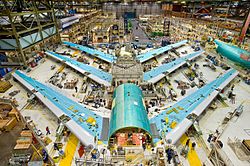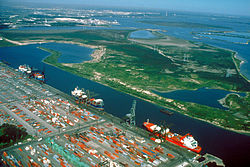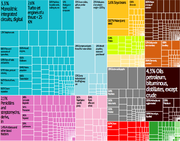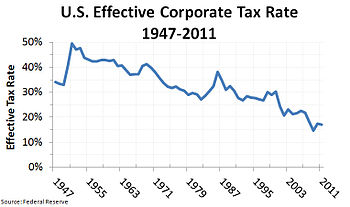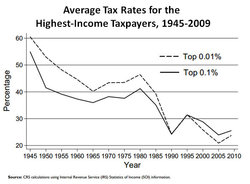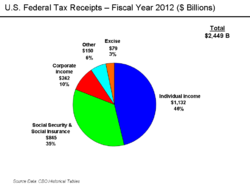
Economy of the United States
Background to the schools Wikipedia
This selection is made for schools by a children's charity read more. SOS Children is the world's largest charity giving orphaned and abandoned children the chance of family life.
| Economy of the United States of America | |
|---|---|
 New York City, financial centre of the United States |
|
| Rank | 1st (nominal) / 1st (PPP) |
| Currency | US$ (USD) |
| Fiscal year | October 1 – September 30 |
| Statistics | |
| GDP | $15.851 trillion (Q4 2012) |
| GDP growth | 1.6% (Real, Dec. 2011-Dec. 2012) |
| GDP per capita | $49,601 (2012) ( 14th–2011, nominal; 6th–2011, PPP) |
| GDP by sector | agriculture: 1.2%, industry: 19.2%, services: 79.6% (2011 est.) |
| Inflation ( CPI) | 1.6% (January 2012-January 2013) |
| Population below poverty line |
15.0% (2011) |
| Gini coefficient | 0.477 (2011) ( List of countries) |
| Labor force | 155.654 million (includes 12.332 mil. unemployed, January 2013) |
| Labor force by occupation |
farming, forestry, and fishing: 0.7% manufacturing, extraction, transportation, and crafts: 20.3% managerial, professional, and technical: 37.3% sales and office: 24.2% other services: 17.6% (2009) [note: figures exclude the unemployed] |
| Unemployment | 7.9% (January 2013) |
| Average gross salary | $45,230 (May 2011) |
| Main industries | Highly diversified, world leading, high-technology innovator, second largest industrial output in world; petroleum, steel, motor vehicles, aerospace, telecommunications, chemicals, electronics, food processing, consumer goods, lumber, mining |
| Ease of Doing Business Rank | 4th |
| External | |
| Exports | $1.564 trillion (2012) |
| Export goods | capital goods, 27.9%; industrial supplies and materials (except oil fuels), 24.8%; consumer goods (except automotive), 11.8%; automotive vehicles and components, 9.4%; food, feed, and beverages, 8.6%; fuel oil and petroleum products, 7.6%; aircraft and components, 6.1%; other, 3.8%. |
| Main export partners | Canada 18.9%; Mexico 14.0%; China, 7.1%; Japan, 4.5%; United Kingdom, 3.5% (2012) |
| Imports | $2.299 trillion (2012) |
| Import goods | Consumer goods (except automotive), 22.7%; capital goods (except computing), 18.7; industrial supplies (except crude oil), 18.4%; crude oil, 13.7%; automotive vehicles and components, 13.1%; computers and accesories, 5.4%; food, feed, and beverages, 4.8%; other, 3.1%. |
| Main import partners | China, 18.7%; Canada, 14.2%; Mexico, 12.2%; Japan, 6.4%; Germany, 4.8% (2012) |
| FDI stock | $227.9 billion (2011) |
| Gross external debt | $14.71 trillion / 98% of GDP (as of June 2011) |
| Public finances | |
| Public debt | $16.687 trillion / 107.18% of GDP |
| Budget deficit | $1.09 trillion (2012) |
| Revenues | $2.45 trillion (individual income tax, 46.1%; social insurance, 34.7%; corporate taxes, 9.9%; other, 9.3% - 2012) |
| Expenses | $3.54 trillion (Social Security, 21.5%; defense, 18.4%; Medicare, 13.2%; interest, 7.3%; Medicaid, 7.1%; other, 32.4% - 2012) |
| Economic aid | ODA $19 billion, 0.2% of GDP (2004) |
| Credit rating |
|
| Foreign reserves | $151.866 billion (Dec. 2012) |
|
Main data source: CIA World Fact Book |
|
- Throughout this article, the unqualified term "dollar" and the $ symbol refer to the US dollar.
The economy of the United States is the world's largest national economy and the world's second largest overall economy, the GDP of the EU being approximately $2 trillion larger. Its nominal GDP was estimated to be $15.8 trillion in 2012 , approximately a quarter of nominal global GDP. Its GDP at purchasing power parity is the largest in the world, approximately a fifth of global GDP at purchasing power parity. The U.S. is one of the world's wealthiest nations, with abundant natural resources, a well-developed infrastructure, and high productivity. It has the world's sixth-highest per capita GDP (PPP).
The U.S. is the world's third-largest producer of oil and second-largest producer of natural gas. It is the second-largest trading nation in the world behind China. Its five largest trading partners are : European Union, Canada, China, Mexico and Japan.
The United States has a mixed economy and has maintained a stable overall GDP growth rate, a moderate unemployment rate, and high levels of research and capital investment. It has been the world's largest national economy (not including colonial empires) since at least the 1890s. As of 2010, the country remains the world's largest manufacturer, representing a fifth of the global manufacturing output.
Of the world's 500 largest companies, 132 are headquartered in the United States. This is twice the total of any other country. The labor market in the United States has attracted immigrants from all over the world and its net migration rate is among the highest in the world. The U.S. is one of the top-performing economies in studies such as the Ease of Doing Business Index, the Global Competitiveness Report, and others. The United States is ranked first globally in the IT industry competitiveness index.
About 60% of the global currency reserves have been invested in the United States dollar, while 24% have been invested in the euro. The country is one of the world's largest and most influential financial markets. The New York Stock Exchange (formally known as NYSE Euronext) is the world's largest stock exchange by market capitalization. Foreign investments made in the United States total almost $2.4 trillion, which is more than twice that of any other country. American investments in foreign countries total over $3.3 trillion, which is almost twice that of any other country. Total public and private debt was $50.2 trillion at the end of the first quarter of 2010, or 3.5 times GDP. In October 2012, the proportion of public debt was about 1.0043 times the GDP. Domestic financial assets totaled $131 trillion and domestic financial liabilities totaled $106 trillion.
The US economy is orderly reviewed with comprehensive economic data analysis by the Beige Book of the Federal Reserve System, the Bureau of Economic Analysis of the Department of Commerce, the Bureau of Labor Statistics of the United States Department of Labor and economic indicators of the United States Census.
The United States' economy is currently embroiled in the economic downturn which followed the Financial crisis of 2007–2008, with output still below potential according to the CBO and unemployment still above historic trends as of late 2012.
History
The economic history of the United States has its roots in European settlements in the 16th, 17th, and 18th centuries. The American colonies went from marginally successful colonial economies to a small, independent farming economy, which in 1776 became the United States of America. In 180 years the United States grew to a huge, integrated, industrialized economy that still makes up over a quarter of the world economy. As a result, the U.S.'s GDP per capita converged on and eventually surpassed that of the U.K., as well as other nations that it previously trailed economically. The economy has maintained high wages, attracting immigrants by the millions from all over the world.
In the 19th century, recessions frequently coincided with financial crises.
The Panic of 1837 was followed by a five-year depression, with the failure of banks and then-record-high unemployment levels. Because of the great changes in the economy over the centuries, it is difficult to compare the severity of modern recessions to early recessions. Recessions after World War II appear to have been less severe than earlier recessions, but the reasons for this are unclear.
World's largest economy
The United States has been the world's largest national economy since at least the 1920s. For many years following the Great Depression of the 1930s, when danger of recession appeared most serious, the government strengthened the economy by spending heavily itself or cutting taxes so that consumers would spend more, and by fostering rapid growth in the money supply, which also encouraged more spending. Ideas about the best tools for stabilizing the economy changed substantially between the 1930s and the 1980s. From the New Deal era that began in 1933, to the Great Society initiatives of the 1960s, national policy makers relied principally on fiscal policy to influence the economy.
The approach, advanced by British economist John Maynard Keynes, gave elected officials a leading role in directing the economy, since spending and taxes are controlled by the U.S. President and the Congress. The "Baby Boom" saw a dramatic increase in fertility in the period 1942–1957; it was caused by delayed marriages and childbearing during depression years, a surge in prosperity, a demand for suburban single-family homes (as opposed to inner city apartments) and new optimism about the future. The boom crested about 1957, then slowly declined. A period of high inflation, interest rates and unemployment after 1973 weakened confidence in fiscal policy as a tool for regulating the overall pace of economic activity.
The U.S. economy grew by an average of 3.8% from 1946 to 1973, while real median household income surged 74% (or 2.1% a year). The economy since 1973, however, has been characterized by both slower growth (averaging 2.7%), and nearly stagnant living standards, with household incomes increasing by 10%, or only 0.3% annually.
The worst recession in recent decades, in terms of lost output, occurred during the 2008 financial crisis, when GDP fell by 5.0% from the spring of 2008 to the spring of 2009. Other significant recessions took place in 1957–58, when GDP fell 3.7%, following the 1973 oil crisis, with a 3.1% fall from late 1973 to early 1975, and in the 1981–82 recession, when GDP dropped by 2.9%. Recent, mild recessions have included the 1990–91 downturn, when output fell by 1.3%, and the 2001 recession, in which GDP slid by 0.3%; the 2001 downturn lasted just eight months. The most vigorous, sustained periods of growth, on the other hand, took place from early 1961 to mid 1969, with an expansion of 53% (5.1% a year), from mid 1991 to late in 2000, at 43% (3.8% a year), and from late 1982 to mid 1990, at 37% (4% a year).
In the 1970s and 1980s, it was popular in the U.S. to believe that Japan's economy would surpass that of the United States, but this didn't happen.
Improving economies of some emerging countries
Since the 1970s several emerging countries have begun to close the economic gap with the United States. In most cases, this has been due to moving the manufacture of goods formerly made in the U.S. to countries where they could be made for sufficiently less money to cover the cost of shipping plus a higher profit.
In other cases, some countries have gradually learned to produce the same products and services that previously only the U.S. and a few other countries could produce. Real income growth in the U.S. has slowed.
The North American Free Trade Agreement, or NAFTA, created the largest trade bloc in the world in 1994.
Since 1976, the US has sustained merchandise trade deficits with other nations, and since 1982, current account deficits. The nation's long-standing surplus in its trade in services was maintained, however, and reached a record US$195 billion in 2012. In recent years, the primary economic concerns have centered on: high household debt ($11 trillion, including $2.5 trillion in revolving debt), high net national debt ($9 trillion), high corporate debt ($9 trillion), high mortgage debt (over $15 trillion as of 2005 year-end), high external debt (amount owed to foreign lenders), high trade deficits, a serious deterioration in the United States net international investment position (NIIP) (−24% of GDP), and high unemployment. In 2006, the U.S. economy had its lowest saving rate since 1933. These issues have raised concerns among economists and national politicians.
The United States economy experienced a crisis in 2008 led by a derivatives market and subprime mortgage crisis, and a declining dollar value. On December 1, 2008, the NBER declared that the United States entered a recession in December 2007, citing employment and production figures as well as the third quarter decline in GDP. The recession did, however, lead to a reduction in record trade deficits, which fell from $840 billion annually during the 2006–08 period, to $500 billion in 2009, as well as to higher personal savings rates, which jumped from a historic low of 1% in early 2008, to nearly 5% in late 2009. The merchandise trade deficit rose to $670 billion in 2010; savings rates, however, remained at around 5%.
The U.S. public debt was $909 billion in 1980, an amount equal to 33.3% of America's gross domestic product (GDP; by 1990, that number had more than tripled to $3.2 trillion – or 55.9% of GDP. In 2001 the national debt was $5.7 trillion; however, the debt-to-GDP ratio remained at 1990 levels. Debt levels rose quickly in the following decade, and on January 28, 2010, the US debt ceiling was raised to $14.3 trillion dollars. Based on the 2010 U.S. budget, total national debt will grow to nearly 100% of GDP, versus a level of approximately 80% in early 2009. The White House estimates that the government’s tab for servicing the debt will exceed $700 billion a year in 2019, up from $202 billion in 2009.
The U.S. Treasury statistics indicate that, at the end of 2006, non-US citizens and institutions held 44% of federal debt held by the public. China, holding $801.5 billion in treasury bonds, is the largest foreign financier of the record U.S. public debt.
US share of world GDP (nominal) peaked in 1985 with 32.74% of global GDP (nominal). Its second highest share was 32.24% in 2001.
US share of world GDP (PPP) peaked in 1999 with 23.78% of global GDP (PPP). While its share has been declining each year since 1999, it is still the highest in the world.
Overview
A central feature of the U.S. economy is the economic freedom afforded to the private sector by allowing the private sector to make the majority of economic decisions in determining the direction and scale of what the U.S. economy produces. This is enhanced by relatively low levels of regulation and government involvement, as well as a court system that generally protects property rights and enforces contracts. Today, the United States is home to 29.6 million small businesses, 30% of the world's millionaires, 40% of the world's billionaires, as well as 139 of the world's 500 largest companies.
From its emergence as an independent nation, the United States has encouraged science and innovation. As a result, the United States has been the birthplace of 161 of Britannica's 321 Great Inventions, including items such as the airplane, internet, microchip, laser, cellphone, refrigerator, email, microwave, Personal Computer, LCD and LED technology, air conditioning, assembly line, supermarket, bar code, electric motor, ATM, and many more.
The United States is rich in mineral resources and fertile farm soil, and it is fortunate to have a moderate climate. It also has extensive coastlines on both the Atlantic and Pacific Oceans, as well as on the Gulf of Mexico. Rivers flow from far within the continent and the Great Lakes—five large, inland lakes along the U.S. border with Canada—provide additional shipping access. These extensive waterways have helped shape the country's economic growth over the years and helped bind America's 50 individual states together in a single economic unit.
The number of workers and, more importantly, their productivity help determine the health of the U.S. economy. Throughout its history, the United States has experienced steady growth in the labor force, a phenomenon that is both cause and effect of almost constant economic expansion. Until shortly after World War I, most workers were immigrants from Europe, their immediate descendants, or African Americans who were mostly slaves taken from Africa, or slave descendants.
Beginning in the late 20th century, many Latin Americans immigrated, followed by large numbers of Asians after the removal of nation-origin based immigration quotas. The promise of high wages brings many highly skilled workers from around the world to the United States. Over 13 million people entered the United States during the 1990s alone.
Labor mobility has also been important to the capacity of the American economy to adapt to changing conditions. When immigrants flooded labor markets on the East Coast, many workers moved inland, often to farmland waiting to be tilled. Similarly, economic opportunities in industrial, northern cities attracted black Americans from southern farms in the first half of the 20th century, in what was known as the Great Migration.
In the United States, the corporation has emerged as an association of owners, known as stockholders, who form a business enterprise governed by a complex set of rules and customs. Brought on by the process of mass production, corporations, such as General Electric, have been instrumental in shaping the United States. Through the stock market, American banks and investors have grown their economy by investing and withdrawing capital from profitable corporations. Today in the era of globalization, American investors and corporations have influence all over the world. The American government is also included among the major investors in the American economy. Government investments have been directed towards public works of scale (such as from the Hoover Dam), military-industrial contracts, and the financial industry.
Employment
There are approximately 154.4 million employed individuals in the US. Government is the largest employment sector with 22 million. Small businesses are the largest employer in the country representing 53% of US workers. The second largest share of employment belongs to large businesses that employ 38% of the US workforce.
The private sector employs 91% of Americans. Government accounts for 8% of all US workers. Over 99% of all employing organizations in the US are small businesses. The 30 million small businesses in the U.S. account for 64% of newly created jobs (those created minus those lost). Jobs in small businesses accounted for 70% of those created in the last decade.
The proportion of Americans employed by small business versus large business has remained relatively the same year by year as some small businesses become large businesses and just over half of small businesses survive more than 5 years. Amongst large businesses, several of the largest companies and employers in the world are American companies. Amongst them are Walmart, the largest company and the largest private sector employer in the world, which employs 2.1 million people world-wide and 1.4 million in the US alone.
There are nearly 30 million small businesses in the US. Minorities such as Hispanics, African Americans, Asian Americans, and Native Americans (35% of the country's population), own 4.1 million of the country's businesses. Minority-owned businesses generate almost $700 billion in revenue and employ almost 5 million workers in the U.S.
The median household income in the US as of 2008 is $52,029. About 284,000 working people in the US have two full-time jobs and 7.6 million have a part-time job in addition to their full-time employment. Of working individuals in the US, 12% belong to a labor union; most union members are government workers.
Unemployment
In May 2009, the unemployment rate was 9.4%. A broader measure of unemployment (taking into account marginally attached workers, those employed part-time for economic reasons, and discouraged workers) was 15.9%. In 2009 and 2010, following the financial crisis of 2007–2010, the emerging problem of jobless recoveries resulted in record levels of long-term unemployment with over 6 million workers looking for work longer than 6 months as of January, 2010. This particularly affected older workers. Since the recession's end in June 2009 in the United States, immigrants have gained 656,000 jobs, while U.S.-born workers lost more than a million jobs.
In April 2010, the official unemployment rate was 9.9%, but the government’s broader U-6 unemployment rate was 17.1%. In the period between February 2008 and February 2010, the number of people working part-time for economic reasons has increased by 4 million to 8.8 million, an 83% increase in part-time workers during the two-year period.
Female unemployment continued to be significantly lower than male unemployment (7.5% vs. 9.8%). The unemployment among Caucasians continues to be much lower than African American unemployment (at 8.5% vs. 15.8%). The youth unemployment rate was 18.5% in July 2009, the highest July rate since 1948. The unemployment rate of young African American men was 34.5% in October 2009. Officially, Detroit’s unemployment rate is 27%, but Detroit News suggests that nearly half of this city’s working-age population may be unemployed.
In 1955, 55% of Americans worked in services, between 30% and 35% in industry, and between 10% and 15% in agriculture. By 1980, over 65% were employed in services, between 25% and 30% in industry, and less than 5% in agriculture.
Research, development, and entrepreneurship
The United States has been a leader in scientific research and technological innovation since the late 19th century. In 1876, Alexander Graham Bell was awarded the first U.S. patent for the telephone. Thomas Edison's laboratory developed the phonograph, the first long-lasting light bulb, and the first viable movie camera. Nikola Tesla pioneered the AC induction motor and high frequency power transmission used in radio. In the early 20th century, the automobile companies of Ransom E. Olds and Henry Ford popularized the assembly line. The Wright brothers, in 1903, made the first sustained and controlled heavier-than-air powered flight.
Entrepreneurship is the act of being an entrepreneur, which can be defined as "one who undertakes innovations, finance and business acumen in an effort to transform innovations into economic goods". This may result in new organizations or may be part of revitalizing mature organizations in response to a perceived opportunity.
The most obvious form of entrepreneurship is that of starting new businesses (referred as Startup Company); however, in recent years, the term has been extended to include social and political forms of entrepreneurial activity. When entrepreneurship is describing activities within a firm or large organization it is referred to as intra-preneurship and may include corporate venturing, when large entities spin-off organizations.
According to Paul Reynolds, entrepreneurship scholar and creator of the Global Entrepreneurship Monitor, "by the time they reach their retirement years, half of all working men in the United States probably have a period of self-employment of one or more years; one in four may have engaged in self-employment for six or more years. Participating in a new business creation is a common activity among U.S. workers over the course of their careers." And in recent years has been documented by scholars such as David Audretsch to be a major driver of economic growth in both the United States and Western Europe.
Venture capital, as an industry, originated in the United States and it is still dominated by the U.S. According to the National Venture Capital Association 11% of private sector jobs come from venture capital backed companies and venture capital backed revenue accounts for 21% of US GDP.
Some new American businesses raise investments from angel investors (venture capitalists). In 2010 healthcare/medical accounted for the largest share of angel investments, with 30% of total angel investments (vs. 17% in 2009), followed by software (16% vs. 19% in 2007), biotech (15% vs. 8% in 2009), industrial/energy (8% vs. 17% in 2009), retail (5% vs. 8% in 2009) and IT services (5%).
Americans are “venturesome consumers” who are unusually willing to try new products of all sorts, and to pester manufacturers to improve their products.
Income and wealth

According to the United States Census Bureau, the pretax median household income in 2007 was $50,233. The median ranged from $68,080 in Maryland to $36,338 in Mississippi.
In 2007, the median real annual household income rose 1.3% to $50,233, according to the Census Bureau. The real median earnings of men who worked full-time, year-round climbed between 2006 and 2007, from $43,460 to $45,113. For women, the corresponding increase was from $33,437 to $35,102. The median income per household member (including all working and non-working members above the age of 14) was $26,036 in 2006.
The average home in the United States has more than 700 square feet per person, which is 50%–100% more than the average in other high-income countries. Even in the lowest income percentiles people enjoy more space – average 400 square feet per person – than middle classes in Europe do. Likewise, ownership rates of gadgets and amenities are exceptionally high compared to other countries.
The recently released US Income Mobility Study showed economic growth resulted in rising incomes for most taxpayers over the period from 1996 to 2005. Median incomes of all taxpayers increased by 24 percent after adjusting for inflation. The real incomes of two-thirds of all taxpayers increased over this period. Income mobility of individuals was considerable in the U.S. economy during the 1996 through 2004 period with roughly half of taxpayers who began in the bottom quintile moving up to a higher income group within 10 years. In addition, the median incomes of those initially in the lower income groups increased more than the median incomes of those initially in the higher income groups.
Between June 2007 and November 2008 the global recession led to falling asset prices around the world. Assets owned by Americans lost about a quarter of their value. Since peaking in the second quarter of 2007, household wealth is down $14 trillion. The Fed also said that at the end of 2008, the debt owed by nonfinancial sectors was $33.5 trillion, including household debt valued at $13.8 trillion. About 30% of the entire world's millionaire population resides in the United States (in 2009). The Economist Intelligence Unit estimated in 2008 that there were 16,600,000 millionaires in the U.S. Furthermore, 34% of the world's billionaires are American (in 2011).
Financial position
The overall financial position of the United States as of 2009 includes $50.7 trillion of debt owed by US households, businesses, and governments, representing more than 3.5 times the annual gross domestic product of the United States. As of the first quarter of 2010, domestic financial assetsA totaled $131 trillion and domestic financial liabilities $106 trillion. Tangible assets in 2008 (such as real estate and equipment) for selected sectorsB totaled an additional $56.3 trillion.
Since 2010, the U.S. Treasury has been obtaining negative real interest rates on government debt. Such low rates, outpaced by the inflation rate, occur when the market believes that there are no alternatives with sufficiently low risk, or when popular institutional investments such as insurance companies, pensions, or bond, money market, and balanced mutual funds are required or choose to invest sufficiently large sums in Treasury securities to hedge against risk. Lawrence Summers, Matthew Yglesias and other economists state that at such low rates, government debt borrowing saves taxpayer money, and improves creditworthiness.
In the late 1940s through the early 1970s, the US and UK both reduced their debt burden by about 30% to 40% of GDP per decade by taking advantage of negative real interest rates, but there is no guarantee that government debt rates will continue to stay so low. In January, 2012, the U.S. Treasury Borrowing Advisory Committee of the Securities Industry and Financial Markets Association unanimously recommended that government debt be allowed to auction even lower, at negative absolute interest rates.
Now that the connection between public and private debt is better-known, U.S. combined debts are worrisome. See Causes of the Great Depression: Debt Deflation.
Composition
Although most of the U.S. economy is composed of services, the United States is the world's largest manufacturer, with a 2009 industrial output of US$2.33 trillion. Its manufacturing output is greater than of Germany, France, India, and Brazil combined. Main industries include petroleum, steel, automobiles, construction machinery, aerospace, agricultural machinery, telecommunications, chemicals, electronics, food processing, consumer goods, lumber, and mining. The US leads the world in airplane manufacturing, which represents a large portion of US industrial output. American companies such as Boeing, Cessna (see: Textron), Lockheed Martin (see: Skunk Works), and General Dynamics produce a vast majority of the world's civilian and military aircraft in factories stretching across the United States.
The manufacturing sector of the U.S. economy has experienced substantial job losses over the past several years. In January 2004, the number of such jobs stood at 14.3 million, down by 3.0 million jobs, or 17.5 percent, since July 2000 and about 5.2 million since the historical peak in 1979. Employment in manufacturing was its lowest since July 1950. The number of steel workers fell from 500,000 in 1980 to 224,000 in 2000.

The U.S. produces approximately 18% of the world's manufacturing output, a number that has declined as other nations developed competitive manufacturing industries. The job loss during this continual volume growth is the result of multiple factors including increased productivity, trade, and secular economic trends. In addition, growth in telecommunications, pharmaceuticals, aircraft, heavy machinery and other industries along with declines in low end, low skill industries such as clothing, toys, and other simple manufacturing have resulted in U.S. jobs being more highly skilled and better paying. There has been much debate within the United States on the decline in manufacturing jobs are related to American Unions and lower foreign wages.
Although agriculture comprises less than two percent of the economy, the United States is a net exporter of food. With vast tracts of temperate arable land, technologically advanced agribusiness, and agricultural subsidies, the United States controls almost half of world grain exports. Products include wheat, corn, other grains, fruits, vegetables, cotton; beef, pork, poultry, dairy products; forest products; fish.
Notable companies and markets
In 2011, the 20 largest U.S.-based companies by revenue were Walmart, ExxonMobil, Chevron, ConocoPhillips, Fannie Mae, General Electric, Berkshire Hathaway, General Motors, Ford Motor Company and Hewlett-Packard, AT&T, Cargill, McKesson Corporation, Bank of America, Federal Home Loan Mortgage Corporation, Apple Inc., Verizon, JPMorgan Chase, and Cardinal Health.
In 2011, four of the world's ten largest companies by market capitalization were American: Exxon Mobil, Apple Inc., Chevron Corporation, and Microsoft.
According to Fortune Global 500 2011, the ten largest U.S. employers were Walmart, U.S. Postal Service, IBM, UPS, McDonald's, Target Corporation, Kroger, Home Depot, General Electric, and Sears Holdings.
Apple, Google, IBM, McDonald's, and Microsoft are the world's five most valuable brands in an index published by Millward Brown.
A 2012 Deloitte report published in STORES magazine indicated that of the world's top 250 largest retailers by retail sales revenue in fiscal year 2010, 32% of those retailers were based in the United States, and those 32% accounted for 41% of the total retail sales revenue of the top 250. Amazon.com is the world's largest online retailer.
Half of the world's 20 largest semiconductor manufacturers by sales were American-origin in 2011.
Most of the world's largest charitable foundations were founded by Americans.
American producers create nearly all of the world's highest-grossing films. Many of the world's best-selling music artists are based in the United States. U.S. tourism sector welcomes approximately 60 million international visitors every year.
Energy, transportation, and telecommunications
The United States is the second largest energy consumer in total use. The U.S. ranks seventh in energy consumption per-capita after Canada and a number of other countries. The majority of this energy is derived from fossil fuels: in 2005, it was estimated that 40% of the nation's energy came from petroleum, 23% from coal, and 23% from natural gas. Nuclear power supplied 8.4% and renewable energy supplied 6.8%, which was mainly from hydroelectric dams although other renewables are included.
American dependence on oil imports grew from 24% in 1970 to 65% by the end of 2005. At that rate of unchecked import growth, the US would have been 70% to 75% reliant on foreign oil by about 2015. Transportation has the highest consumption rates, accounting for approximately 68.9% of the oil used in the United States in 2006, and 55% of oil use worldwide as documented in the Hirsch report.
In 2011, the United States imported 3,324 million barrels of crude oil, compared to 3,377 million barrels in 2010. While the U.S. is the largest importer of fuel, the Wall Street Journal reported in 2011 that the country was about to become a net fuel exporter for the first time in 62 years. The paper reported expectations that this would continue until 2020. In fact, petroleum was the major export from the country in 2011.
Internet was developed in the U.S. and the country hosts many of the world's largest hubs.
Finance
Measured by value of its listed companies' securities, the New York Stock Exchange is more than three times larger than any other stock exchange in the world. As of October 2008, the combined capitalization of all domestic NYSE listed companies was US$10.1 trillion.
NASDAQ is another American stock exchange and the world's 3rd largest exchange after the New York Stock Exchange and Japan's Tokyo Stock Exchange. However NASDAQ's trade value is larger than Japan's TSE. NASDAQ is the largest electronic screen-based equity securities trading market in the U.S. With approximately 3,800 companies and corporations, it has more trading volume per hour than any other stock exchange.
International trade
The United States is the world's largest trading nation. There is a high amount of U.S. dollars in circulation all around the planet. The dollar is also used as the standard unit of currency in international markets for commodities such as gold and petroleum.
In 2010, U.S. exports amounted to $1.3 trillion and imports amounted to $1.9 trillion. Trade deficit was $634.9 billion. The deficit on petroleum products was $270 billion. The trade deficit with China was $295 billion in 2011, a new record and up from $304 million in 1983.
The United States had a $168 billion surplus on trade in services, and $803 billion deficit on trade in goods in 2010. China has expanded its foreign exchange reserves, which included $1.6 trillion of U.S. securities as of 2009. In 2010, the ten largest trading partners of the U.S. were Canada, China, Mexico, Japan, Germany, the United Kingdom, South Korea, France, Taiwan, and Brazil.
According to the KOF Index of Globalization and the Globalization Index by A.T. Kearney/Foreign Policy Magazine, the U.S. has a relatively high degree of globalization. U.S. workers send a third of all remittances in the world.
Currency and central bank
The United States dollar is the unit of currency of the United States. The U.S. dollar is the currency most used in international transactions. Several countries use it as their official currency, and in many others it is the de facto currency.
The federal government attempts to use both monetary policy (control of the money supply through mechanisms such as changes in interest rates) and fiscal policy (taxes and spending) to maintain low inflation, high economic growth, and low unemployment. A private central bank, known as the Federal Reserve, was formed in 1913 to supposedly provide a stable currency and monetary policy. The U.S. dollar has been regarded as one of the more stable currencies in the world and many nations back their own currency with U.S. dollar reserves.
The U.S. dollar has maintained its position as the world's primary reserve currency, although it is gradually being challenged in that role. Almost two-thirds of currency reserves held around the world are held in US dollars, compared to around 25% for the next most popular currency, the Euro. Rising US national debt and quantitative easing has caused some to predict that the US Dollar will lose its status as the world's reserve currency, however these predictions have not come to fruition.
Law and government
The United States ranked 4th in the Ease of Doing Business Index in 2012, 18th in the Economic Freedom of the World index by the Fraser Institute in 2012, 10th in the Index of Economic Freedom by the Wall Street Journal and Heritage Foundation in 2012, and 19th in the 2010 Global Enabling Trade Report.
Regulations
The U.S. federal government regulates private enterprise in numerous ways. Regulation falls into two general categories.
Some efforts seek, either directly or indirectly, to control prices. Traditionally, the government has sought to create state-regulated monopolies such as electric utilities from while allowing prices in the level that would ensure them normal profits. At times, the government has extended economic control to other kinds of industries as well. In the years following the Great Depression, it devised a complex system to stabilize prices for agricultural goods, which tend to fluctuate wildly in response to rapidly changing supply and demand. A number of other industries—trucking and, later, airlines—successfully sought regulation themselves to limit what they considered as harmful price-cutting, a process called regulatory capture.
Another form of economic regulation, antitrust law, seeks to strengthen market forces so that direct regulation is unnecessary. The government—and, sometimes, private parties—have used antitrust law to prohibit practices or mergers that would unduly limit competition.
Bank regulation in the United States is highly fragmented compared to other G10 countries where most countries have only one bank regulator. In the U.S., banking is regulated at both the federal and state level. The U.S. also has one of the most highly regulated banking environments in the world; however, many of the regulations are not safety and soundness related, but are instead focused on privacy, disclosure, fraud prevention, anti-money laundering, anti-terrorism, anti- usury lending, and promoting lending to lower-income segments.
Since the 1970s, government has also exercised control over private companies to achieve social goals, such as improving the public's health and safety or maintaining a healthy environment. For example, the Occupational Safety and Health Administration provides and enforces standards for workplace safety, and the United States Environmental Protection Agency provides standards and regulations to maintain air, water, and land resources. The U.S. Food and Drug Administration regulates what drugs may reach the market, and also provides standards of disclosure for food products.
American attitudes about regulation changed substantially during the final three decades of the 20th century. Beginning in the 1970s, policy makers grew increasingly convinced that economic regulation protected companies at the expense of consumers in industries such as airlines and trucking. At the same time, technological changes spawned new competitors in some industries, such as telecommunications, that once were considered natural monopolies. Both developments led to a succession of laws easing regulation.
While leaders of America's two most influential political parties generally favored economic deregulation during the 1970s, 1980s, and 1990s, there was less agreement concerning regulations designed to achieve social goals. Social regulation had assumed growing importance in the years following the Depression and World War II, and again in the 1960s and 1970s. During the 1980s, the government relaxed labor, consumer and environmental rules based on the idea that such regulation interfered with free enterprise, increased the costs of doing business, and thus contributed to inflation. The response to such changes is mixed; many Americans continued to voice concerns about specific events or trends, prompting the government to issue new regulations in some areas, including environmental protection.
Where legislative channels have been unresponsive, some citizens have turned to the courts to address social issues more quickly. For instance, in the 1990s, individuals, and eventually the government itself, sued tobacco companies over the health risks of cigarette smoking. The 1998 Tobacco Master Settlement Agreement provided states with long-term payments to cover medical costs to treat smoking-related illnesses.
Between 2000 and 2008, economic regulation in the United States saw the most rapid expansion since the early 1970s. The number of new pages in the Federal Registry, a proxy for economic regulation, rose from 64,438 new pages in 2001 to 78,090 in new pages in 2007, a record amount of regulation. Economically significant regulations, defined as regulations which cost more than $100 million a year, increased by 70%. Spending on regulation increased by 62% from $26.4 billion to $42.7 billion.
Taxation
Taxation in the United States is a complex system which may involve payment to at least four different levels of government and many methods of taxation. Taxes are levied by the federal government, by the state governments, and often by local governments, which may include counties, municipalities, township, school districts, and other special-purpose districts, which include fire, utility, and transit districts.
Forms of taxation include taxes on income, property, sales, imports, payroll, estates and gifts, as well as various fees. When taxation by all government levels taken into consideration, the total taxation as percentage of GDP was approximately a quarter of GDP in 2011. Share of black market in the U.S. economy is very low compared to other countries.
Expenditure
The United States public-sector spending amounts to about one-third of the GDP.
Each level of government provides many direct services. The federal government, for example, is responsible for national defense, backs research that often leads to the development of new products, conducts space exploration, and runs numerous programs designed to help workers develop workplace skills and find jobs (including higher education). Government spending has a significant effect on local and regional economies—and even on the overall pace of economic activity.
State governments, meanwhile, are responsible for the construction and maintenance of most highways. State, county, or city governments play the leading role in financing and operating public schools. Local governments are primarily responsible for police and fire protection.
The welfare system in the United States began in the 1930s, during the Great Depression. After the Great Society legislation of the 1960s, for the first time "a poor person who was neither elderly nor crippled could eke out a livelihood from the state".
Overall, federal, state, and local spending accounted for almost 28% of gross domestic product in 1998.
As of January 20, 2009, the total U.S. federal debt was $10.627 trillion. The borrowing-cap debt ceiling as of 2005 stood at $8.18 trillion. In March 2006, Congress raised that ceiling an additional $0.79 trillion to $8.97 trillion, which is approximately 68% of GDP. Congress has used this method to deal with an encroaching debt ceiling in previous years, as the federal borrowing limit was raised in 2002 and 2003. As of October 4, 2008, the " Emergency Economic Stabilization Act of 2008" raised the current debt ceiling to US$ 11.3 trillion.
The federal government's debt rose by $1.09 trillion in 2012, and now stands at $16.158 trillion. While the U.S. public debt is the world's largest in absolute size, another measure is its size relative to the nation's GDP. As of October 2012 the debt was 100.4% of GDP. This debt, as a percent of GDP, is still less than the debt of Japan (192%) (the overwhelming number of owners of JGBs are Japanese) and roughly equivalent to those of a few western European nations.















